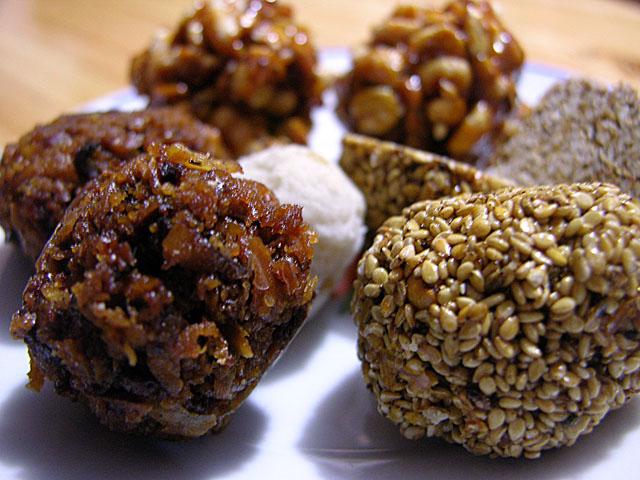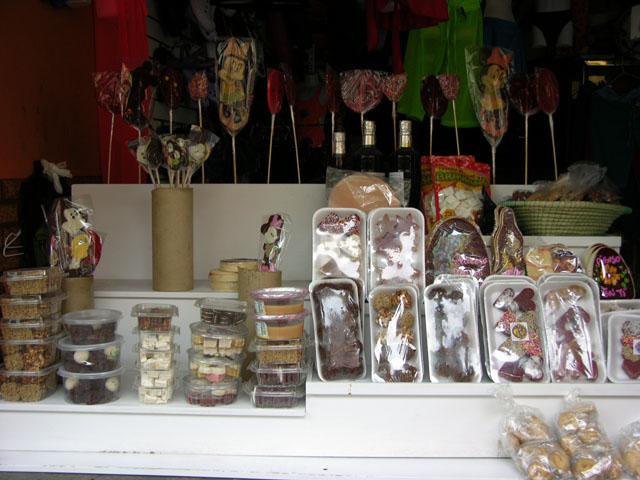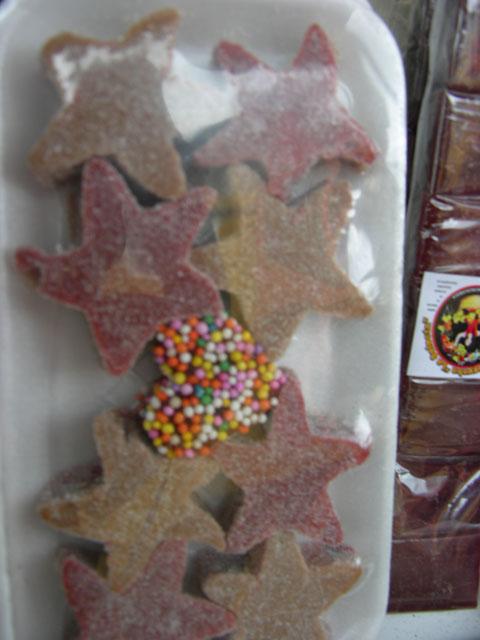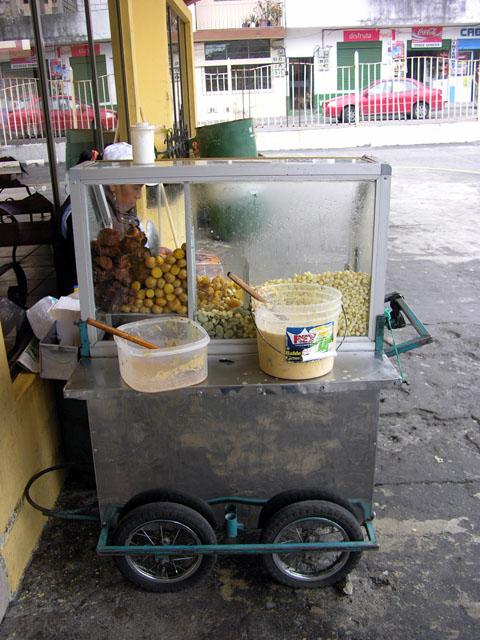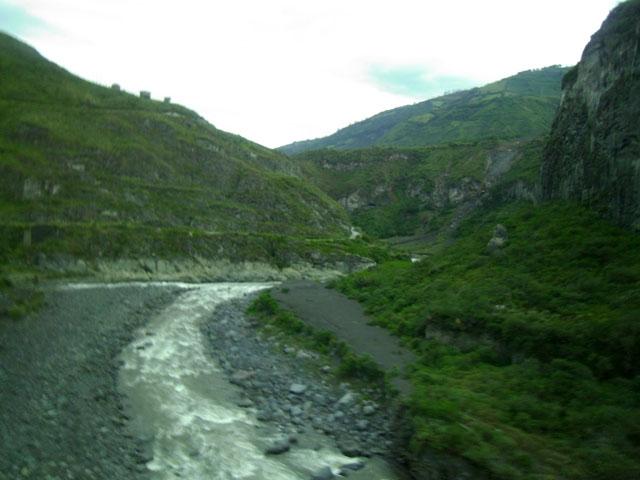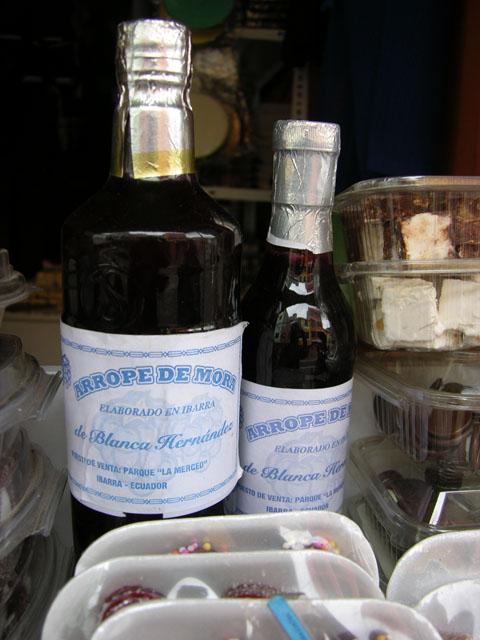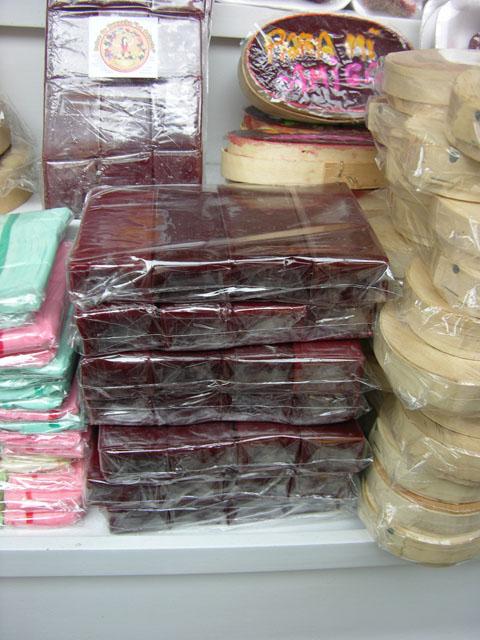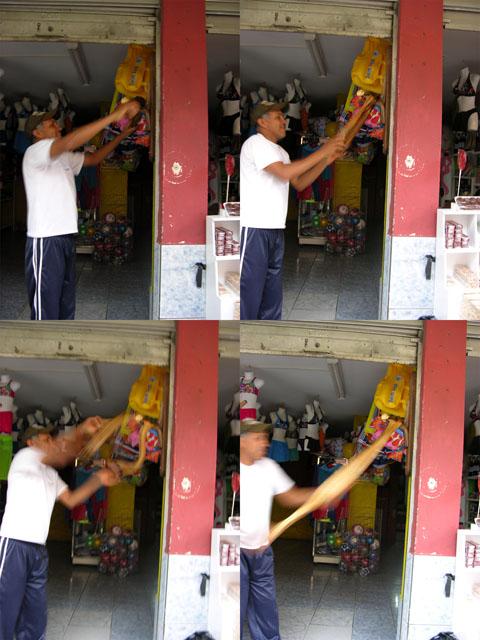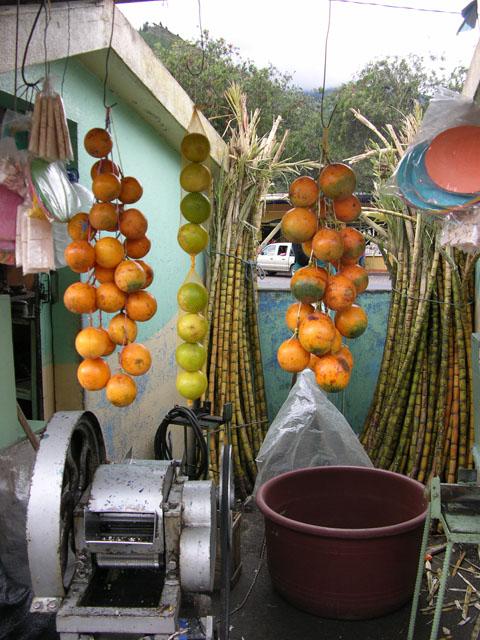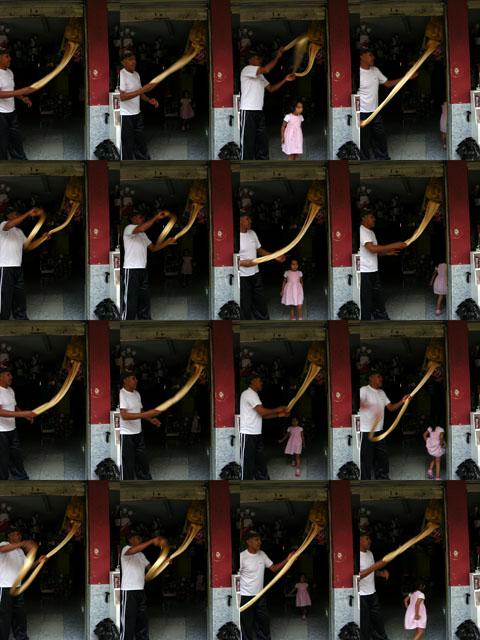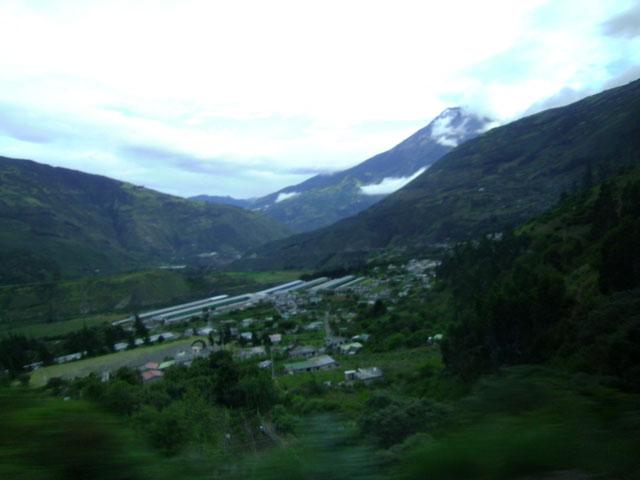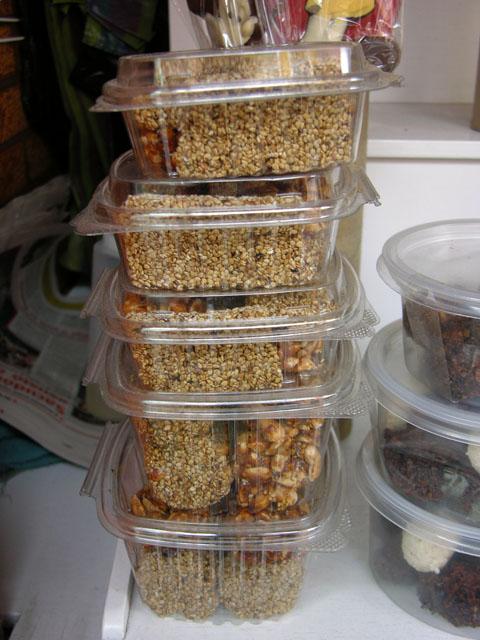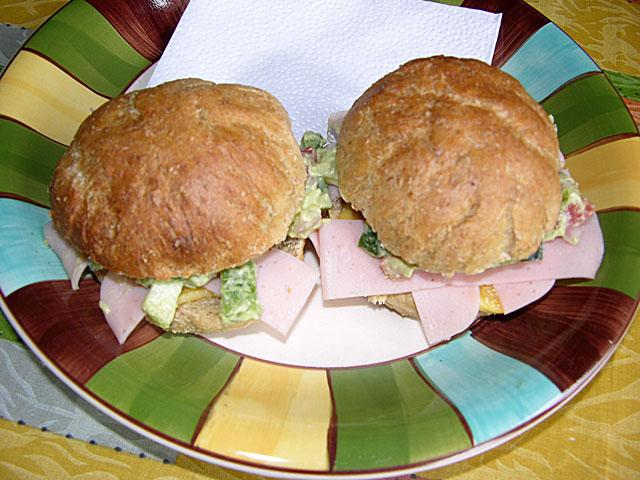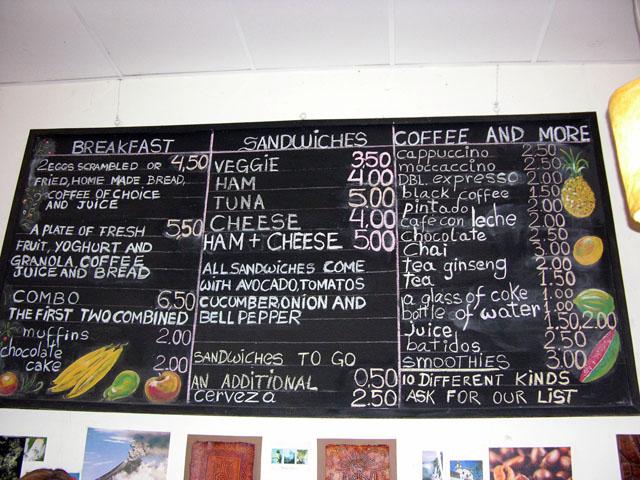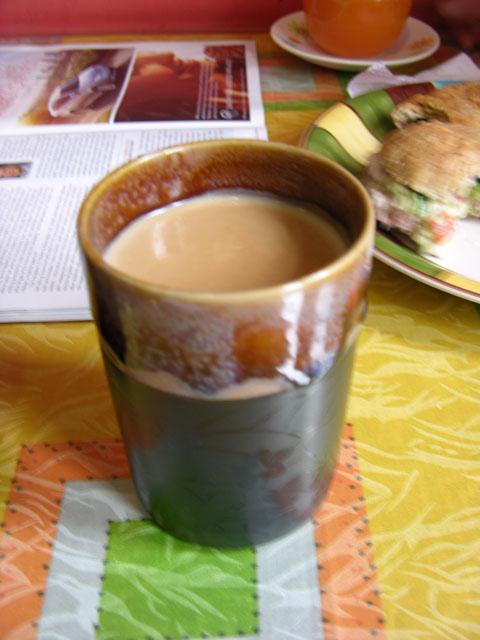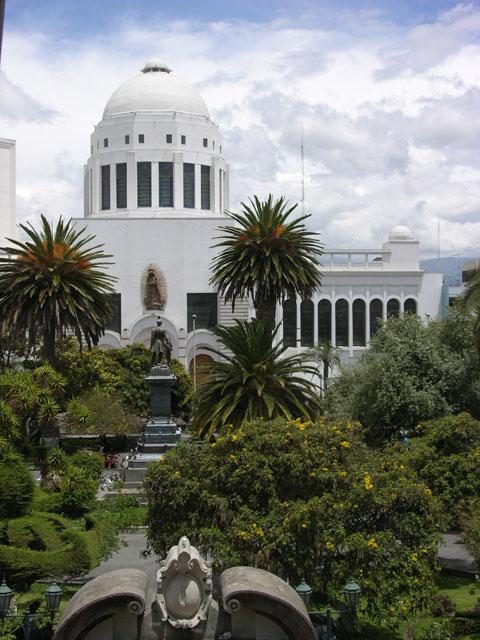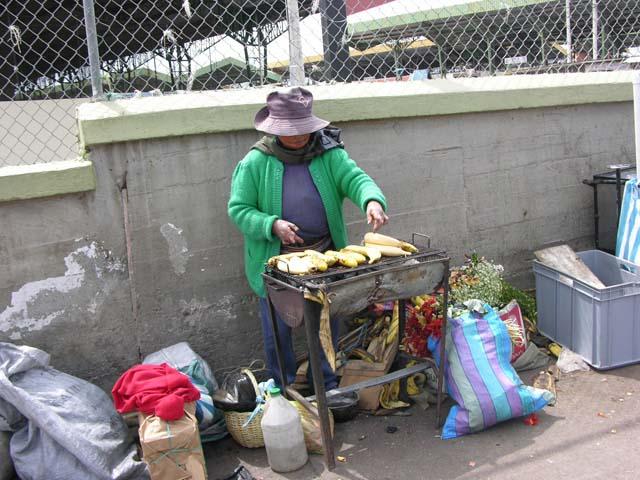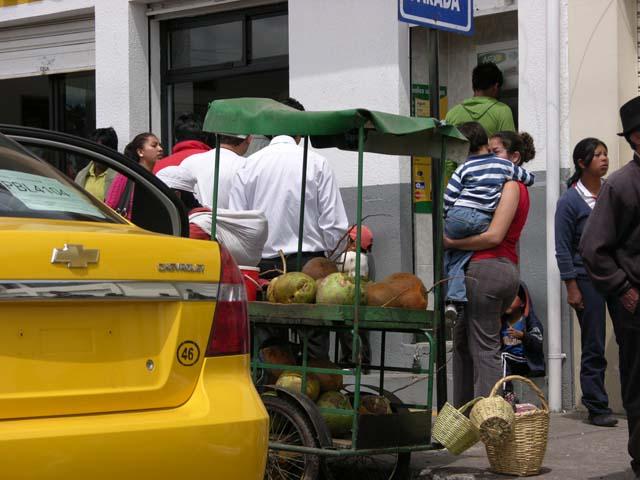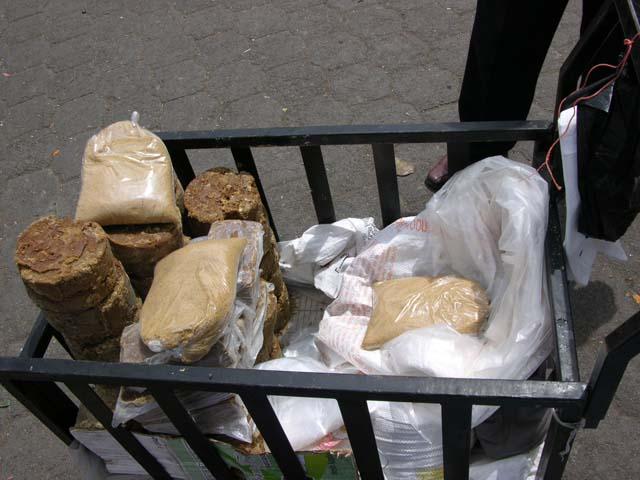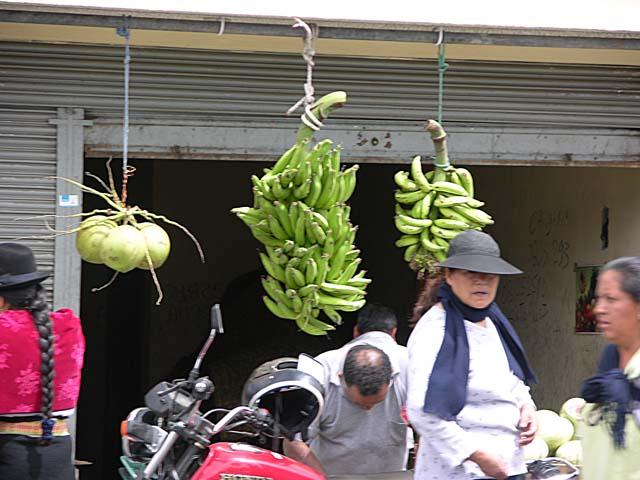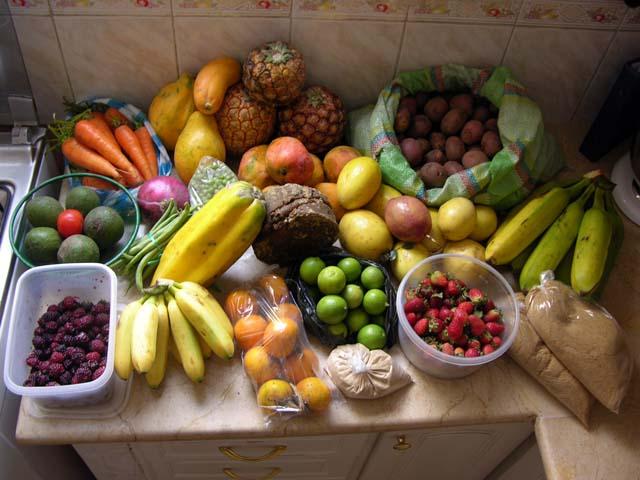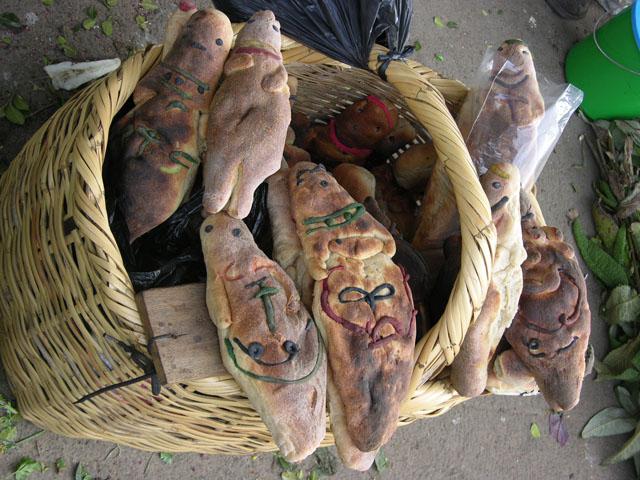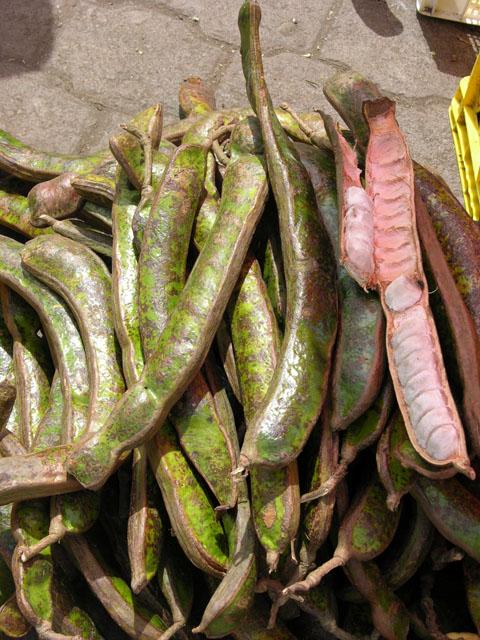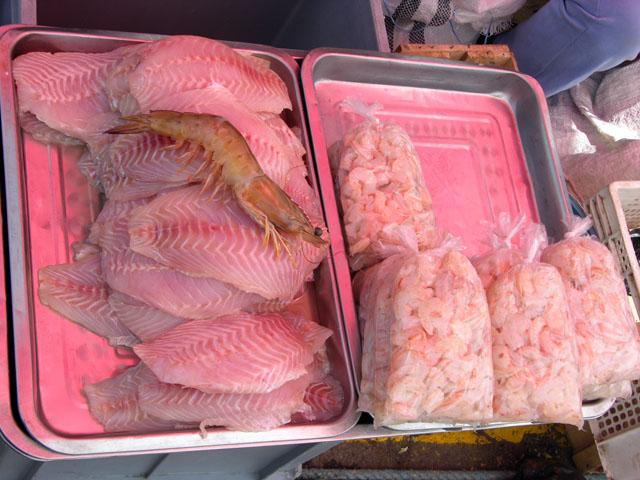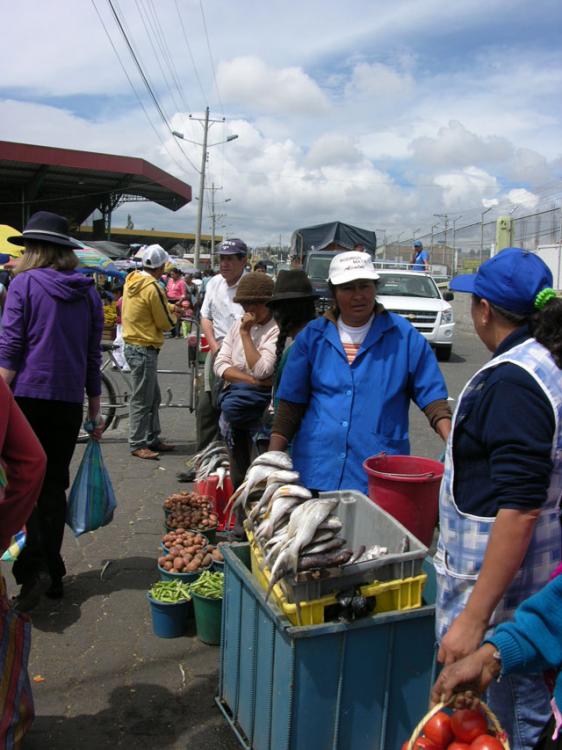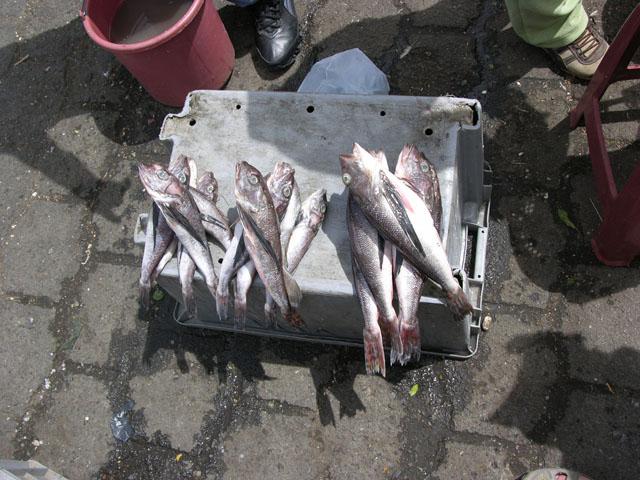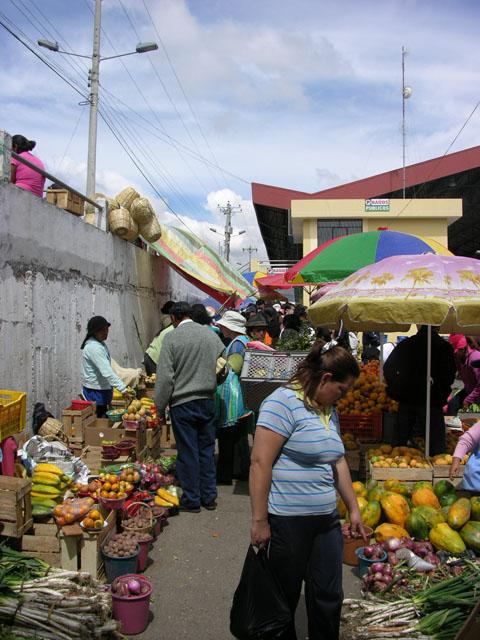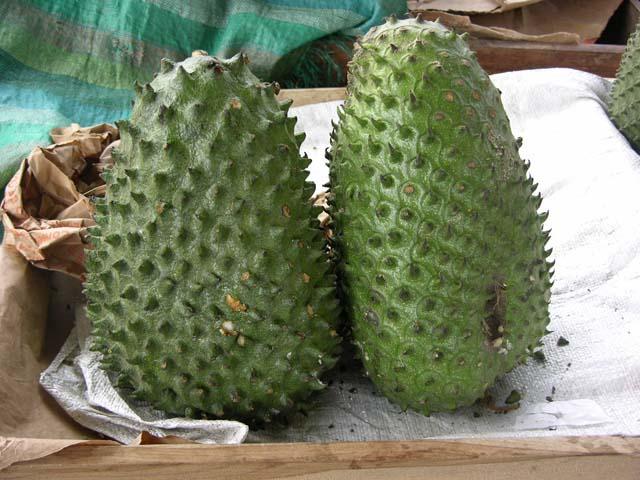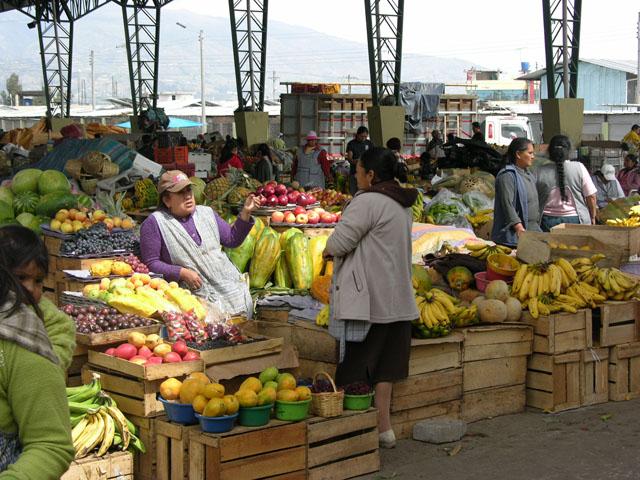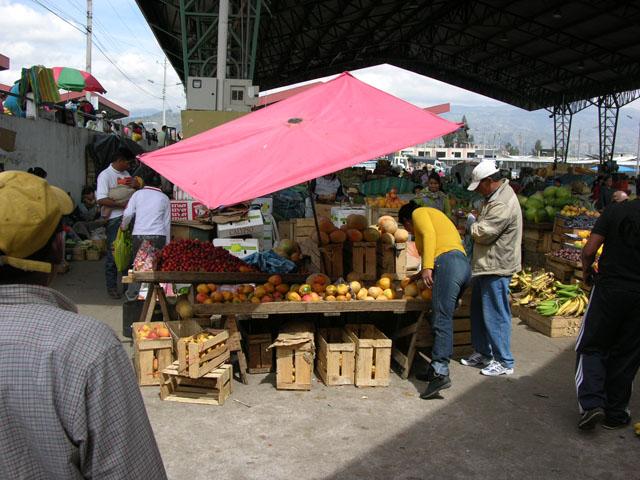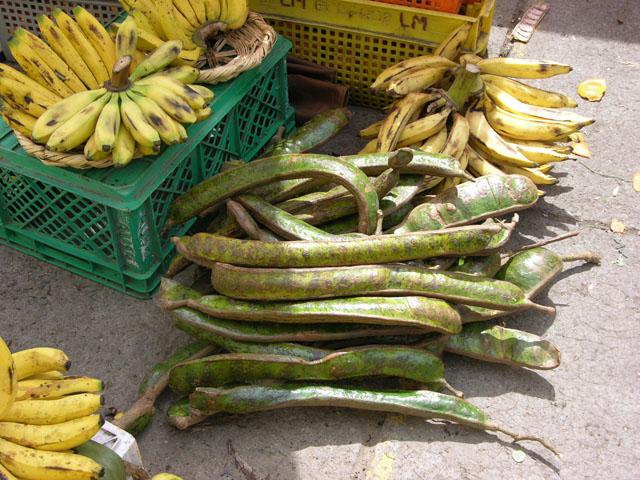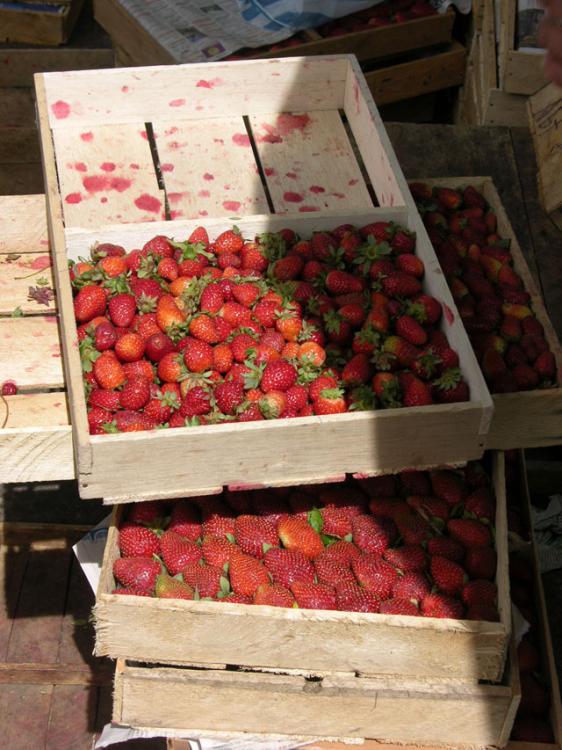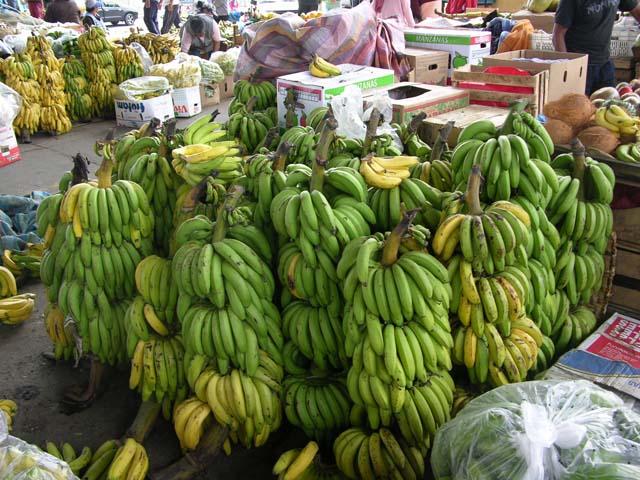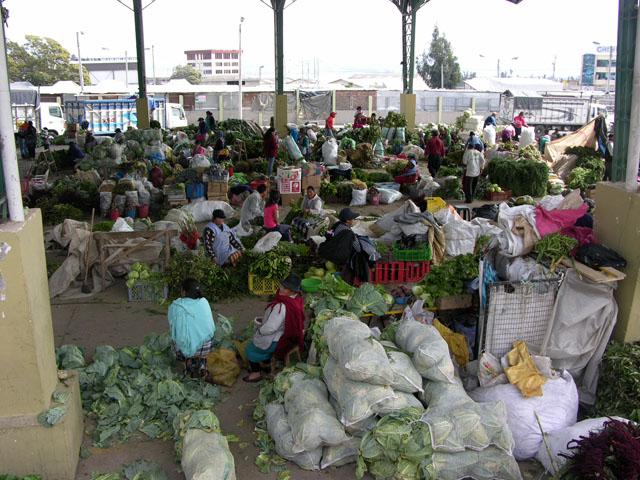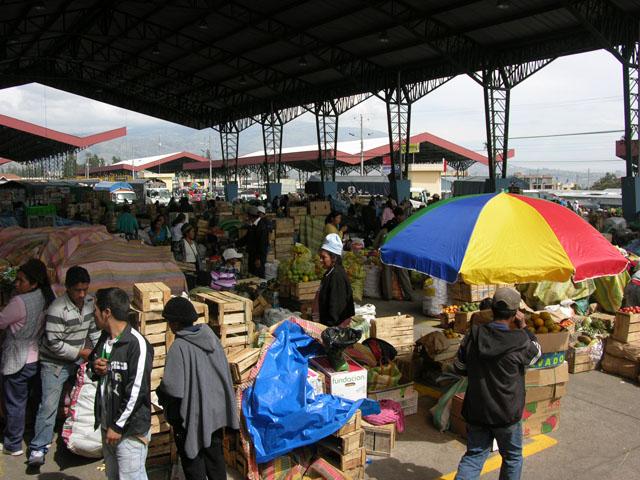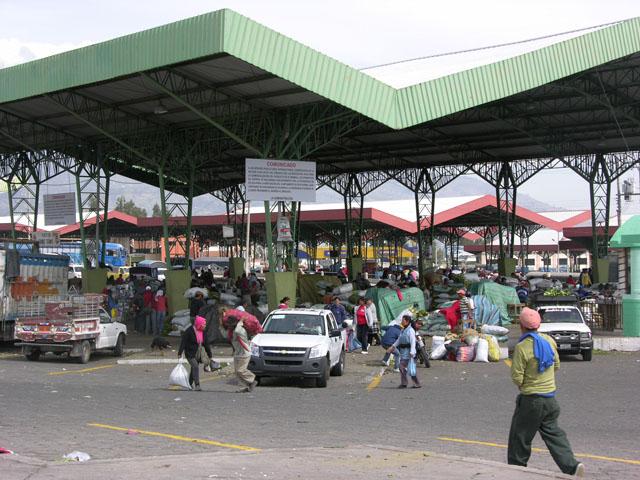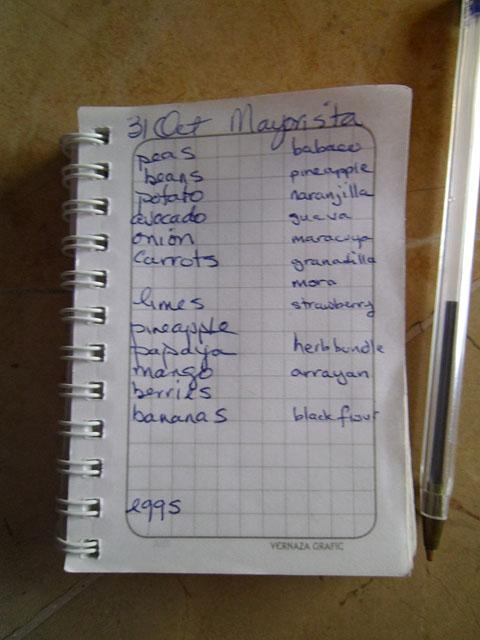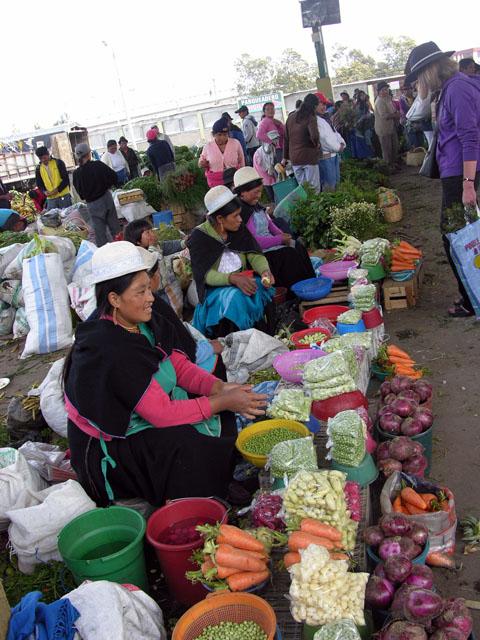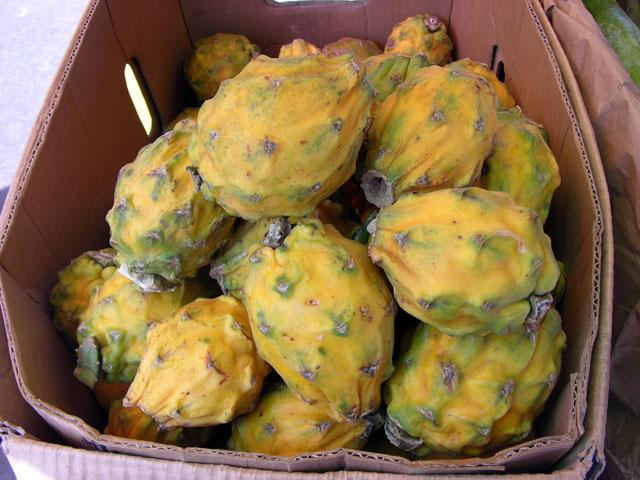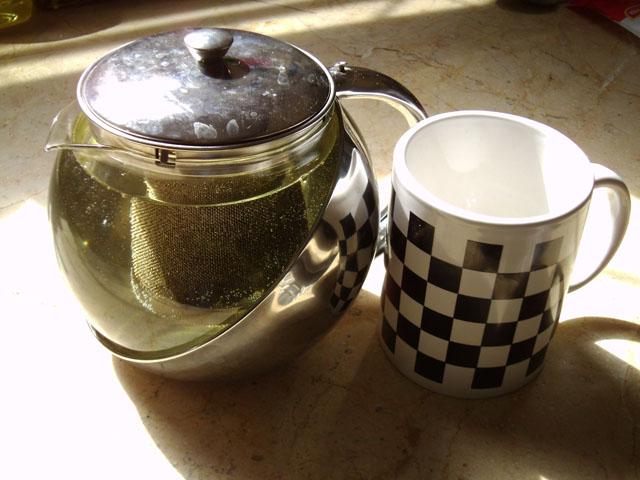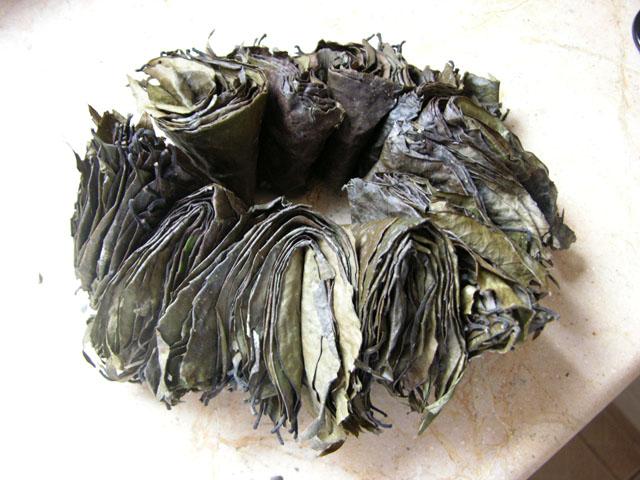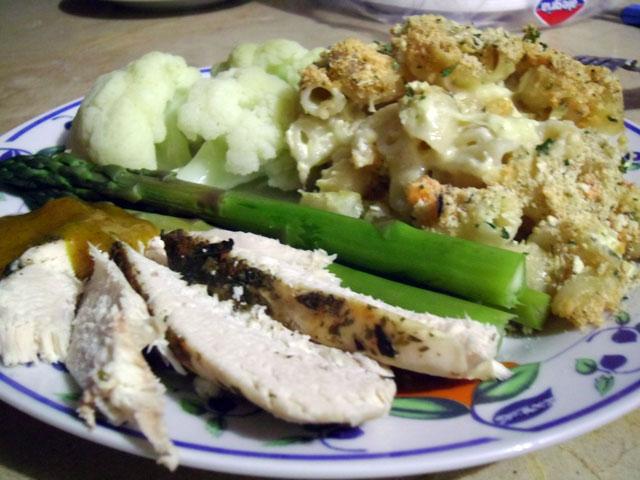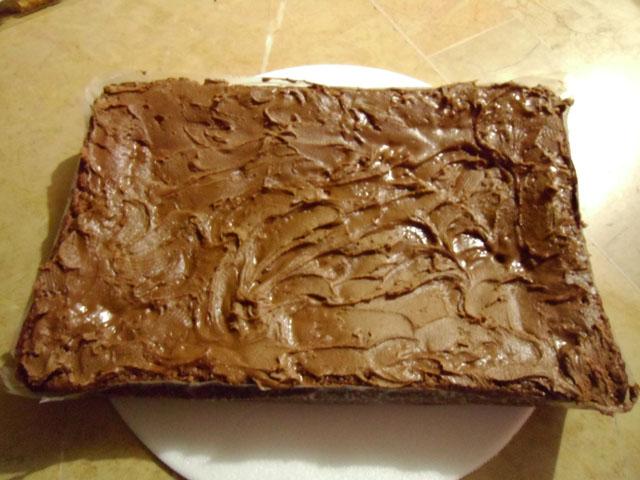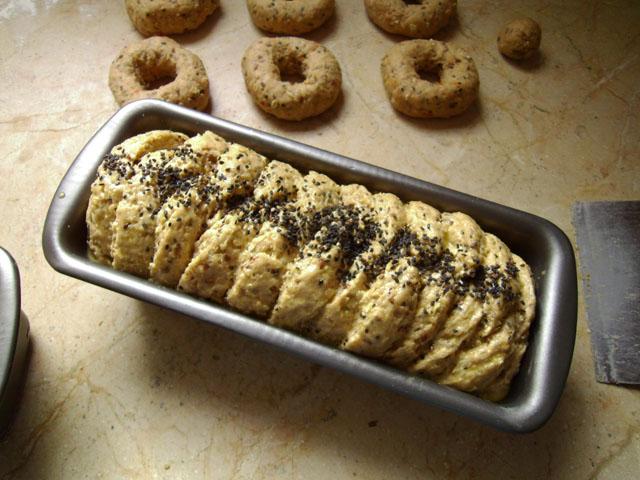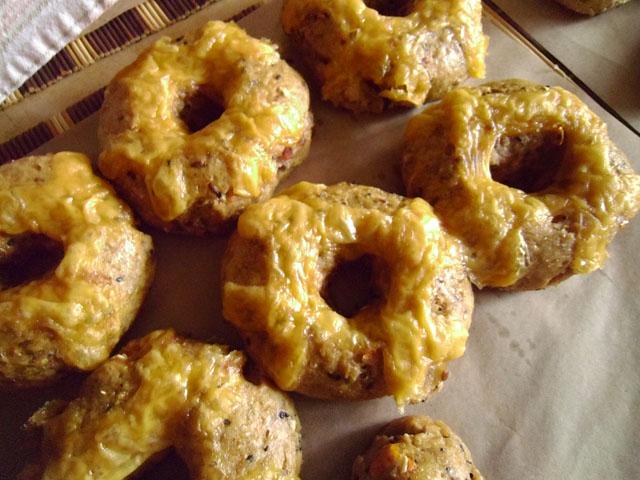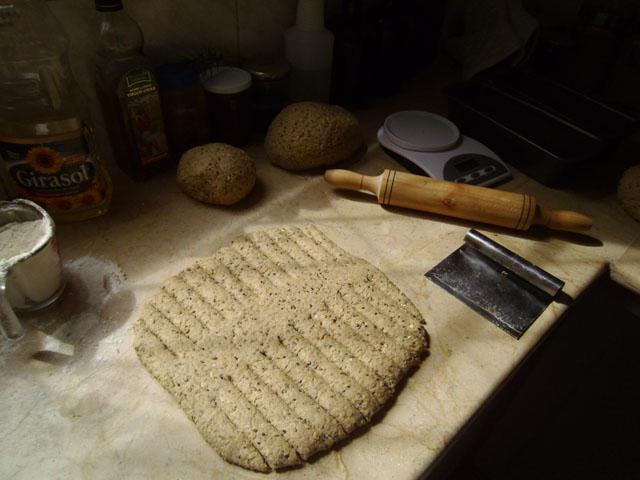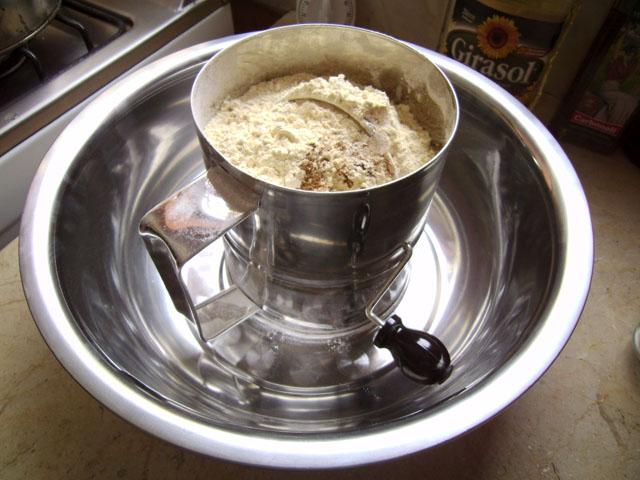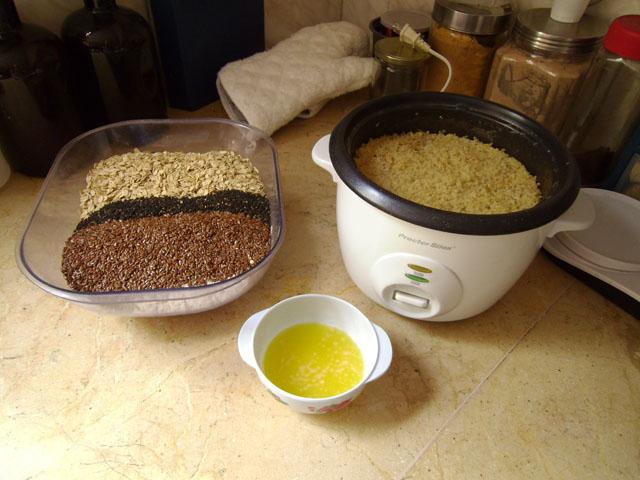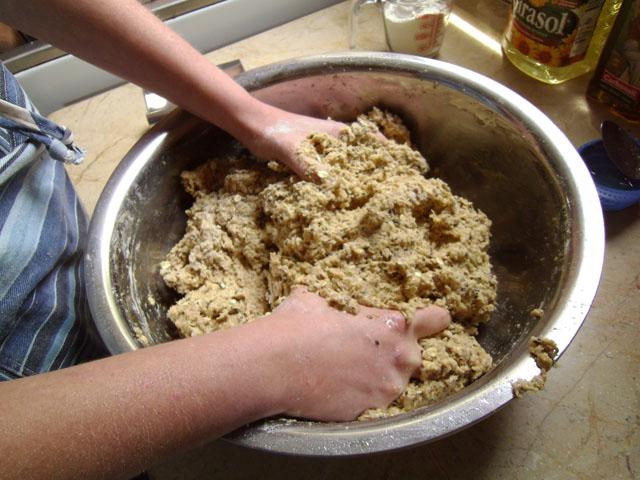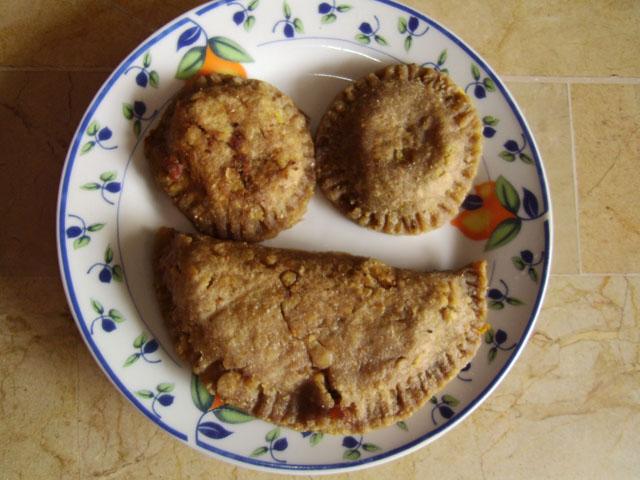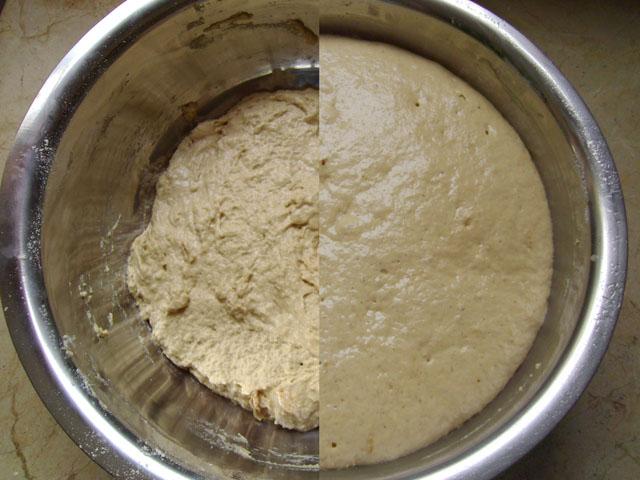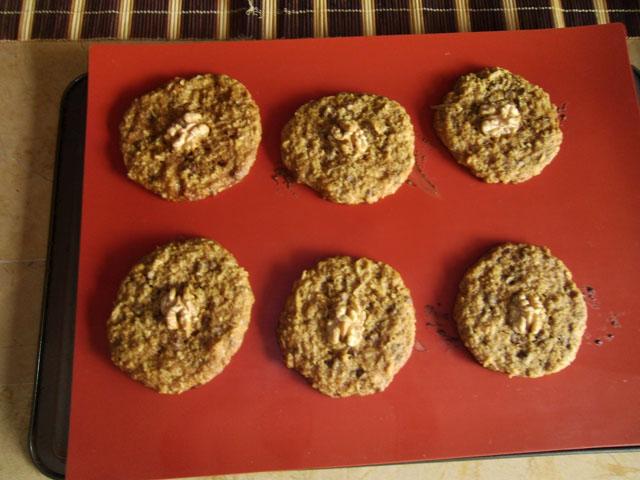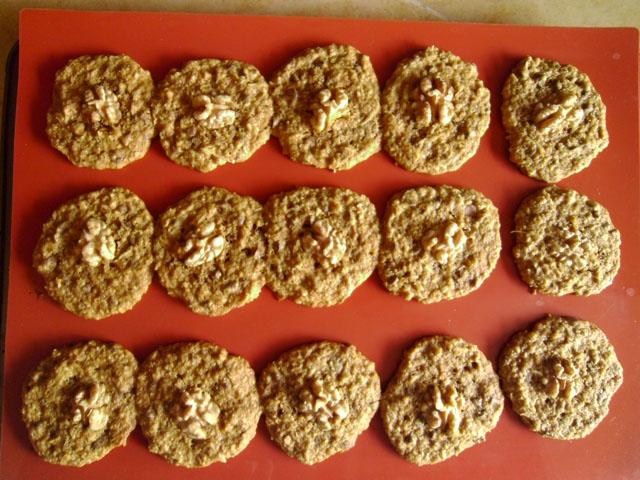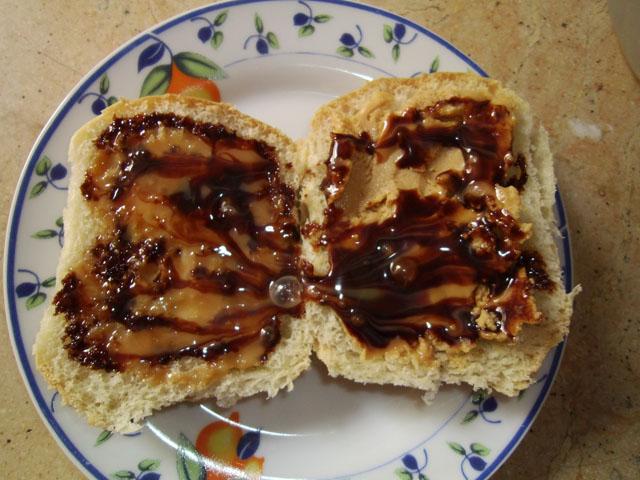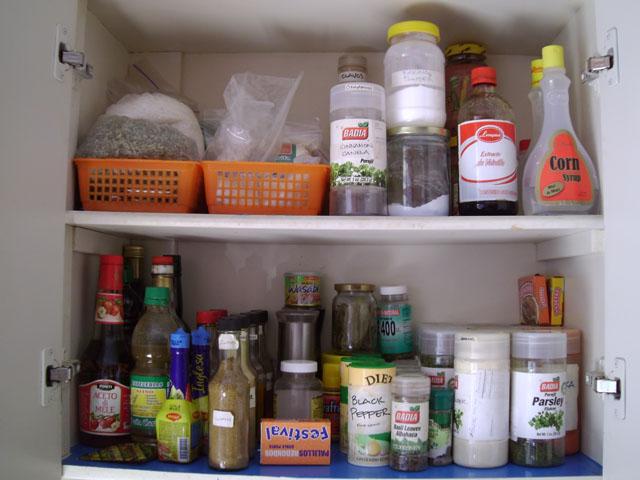-
Posts
2,383 -
Joined
-
Last visited
Content Type
Profiles
Forums
Store
Help Articles
Everything posted by Panaderia Canadiense
-

eG Food Blog: Panaderia Canadiense (2011)
Panaderia Canadiense replied to a topic in Food Traditions & Culture
Dinner last night was a simple affair - paprika roasted Oro Morado potatoes (an Andean heirloom type, with mild purple hearts and gold flesh), steamed beans and carrots, and a nice chunk of flank steak that had been marinading for about a week. In brandy mushroom sauce. Yay Dad - he's the saucier in the family. And for dessert, the molasses balls we brought home from Marcelo's. -

eG Food Blog: Panaderia Canadiense (2011)
Panaderia Canadiense replied to a topic in Food Traditions & Culture
Could well be a corner of the garden, Darienne.... Once we got back from downtown, it was time to go to Baños to deliver the bread, brownie, cookies, and bagels. Baños (or, to give it it's full name, Nuestra Señora de los Baños de Agua Santa, ''Our Lady of the Holy Water Baths) is a hotsprings and sugar town nestled at the foot of active Volcán Tungurahua, which gives the town its mineral springs. Baños is located on the headwaters of the Río Pastaza, one of Ecuador's main Amazon tributaries. Foodwise, it's a mecca for sweets lovers, and is known across the country for its Melcochos and other sugarcane-based confections. We had lunch at Cafe Ali Cumba, a hidden gem off the central square. It's a lunch spot, offering some of the best sandwiches in town, and is one of the only places to get a nice hot mug of Chai outside of Quito. Vibeke, the owner, bakes her own whole-wheat bread. It's also one of the few places to get a really good cup of coffee in the valley - fresh ground and straight into the nifty upright espresso machine. I opted for Ham and Cheese Mom went with Tuna Salad (and obviously enjoyed it!) After lunch, we stopped to chat with Marcelo, a master Melcochero (taffymaker) on Av. Maldonado. He's been making traditional panela taffy for at least 40 years in this same location, although he now also sells swimsuits for forgetful hotsprings goers. Marcelo says the following: one bundle of thirty canes is $45. One cane yeilds 2 L of fresh juice, and 1 L of juice makes 1/4 L of panela syrup. 30 L of syrup makes enough taffy for 50 packs of 5 sticks each. One stick of Melcocho in about 2 inches wide by 5 long. He was kind enough to let us photograph the process of whipping Melcocho, and to give us little tastes throughout the process. These are primarily stop-motion photos, since the actual process of flinging the taffy is incredibly fast. The melcocho begins the colour of molasses and through the pulling and whipping process it gradually lightens up to a pale blonde colour. At the end of the first photo, the texture is still very gummy; at the end of the second photo, it's similar to saltwater taffy, and at the end of the third it's approaching its final texture which is smooth, chewy, and just a bit brittle. Marcelo is one of the few Melcocheros who refuses to use artificial flavours in his confections, preferring instead for the natural richness of the panela to shine through. Snapping the Melcocho into sticks Marcelo's wife makes the other sweets that are available at the stand - among them peanut and molasses brickle balls, sesame molasses balls, sticky coconut-ginger-molasses balls, guava pate de fruit, boiled milk sweets, and turrón (a honey, egg-white, and walnut confection). They also import heavy Mora syrup from the northern city of Ibarra (which is famous for it.) We took an assortment of molasses balls home. On the way out of town are the cane stands, many of which have their own steel trapiches. These vendors sell fresh-expressed cane juice, melcochos, guava sweet, and Macerado, a lightly-fermented cane beer. The whole canes shown here are typical of the area, and are about 8 feet long. There was also a lone Cevichochos and Fritada cart. The fritada smelled excellent, but I was still too full from lunch to consider it! Then back onto the bus for the 45-minute haul back up to Ambato. Tungurahua, who was clouded on the trip in, had shed her clouds. -

eG Food Blog: Panaderia Canadiense (2011)
Panaderia Canadiense replied to a topic in Food Traditions & Culture
The next stop after the market was downtown for a couple of errands. Of course, any time I'm downtown I use the excuse that when downtown one can't be there and not have Helado de Paila! Sr. Segundo Oña and his family have operated this ice-cream cart at the corner of the Cathedral for more than 50 years, and you can have any flavour you wish so long as it's Mora (Andean blackberry). A generous scoop on a handmade cone is 50 cents. -

eG Food Blog: Panaderia Canadiense (2011)
Panaderia Canadiense replied to a topic in Food Traditions & Culture
Those were Mangrove shrimp, most likely. Ambato is only 5 hours from the coast, and the seafood will have been trucked in by the seller, who is from Esmeraldas province. -

eG Food Blog: Panaderia Canadiense (2011)
Panaderia Canadiense replied to a topic in Food Traditions & Culture
And also Manuelo, our friendly neighbourhood Azucero (sugar man) - he runs the trapiche (mill) for the Valle Hermoso region, and sells his panela in the market on Mondays. I buy both milled and block panela from him; this week he had only the blonde grade of both. There's also Mercedes, from whom I (and a number of high-end restaurants) buy eggs. Those stacks are cube-flats of 30 eggs each layer. Heading out, there are a number of tasty things on carts. Among them, charcoal-grilled maduros And young coconuts, for drinking. And the edges of the market are also alive with food. Here's the haul! All told, this (plus the non-pictured eggs and herbs) came to $28.60. -

eG Food Blog: Panaderia Canadiense (2011)
Panaderia Canadiense replied to a topic in Food Traditions & Culture
And now, Market: Part II. Sorry about the delay, folks - I passed out on the sofa after dinner and didn't regain consciousness until about 1 am.... Heading into the main fray of the market, one finds the herb sellers. This week it was important to pay them a visit, since I needed the herb bundles for Colada Morada (more on this when I catch up to today - it's a project) Also here were folks selling Guaguas de Pan that were made in a traditional wood-fired clay dome oven. Up from there are Maria and Mr. Mango (he actually refers to himself that way!) - Maria sells mixed fruit, and Mr. Mango has mangoes, canteloupes.... and Ubos (known to other tropical countries as Natal Plums or Mombins) Maria also sells bananas by the bunch - these are a type called Seda or Silk Plantain, which are similar to export-types. Continuing up the naves, other exotic things are on offer: pastel de hoja (leaf cake, a type of chocolate-plantain cake baked in multiple layers of plantain leaf) Guayabana, aka Soursop There are also vendors whose entire weekly income depends on this Feria. Continuing upwards, there are the Caluma orange sellers and sellers of mixed fruit. The aisle shot gives you an idea of the chaos in this market - it's often a scrum to get the things you want, particularly heading into holidays. For this reason, I don't have a photo of the pineapple-sellers: I had to push my way into a huge clump of people in order to get my chance to bargain for the white-flesh types I prefer. And then one reaches what we call "bananalandia" - the coastal sellers of banana and plantain. In this first photo, apart from Guabos (ice-cream beans), there are four types of yellow-skinned cooking bananas - Seda, Limon, Dominicano, and FHIA-21. Guabos are also one of my favourite fruits, with pulp that tastes almost exactly like vanilla ice-cream. And then there are the Oritos, which I bought. North Americans know a similar type as "Baby" bananas. Heading up again, we come to Anita, who sells the best strawberries in the market. She didn't want her picture taken, but here are her berries! Heading up some more, there are the fish sellers (who I also normally avoid - fish in the hot sun, anyone?) This week featured prawns, shrimp, and corvina, Ocean perch, and Flying fish. There are also more sellers of sierra fruits. And we've almost made it out of the lower Feriada! Up top, there are more mixed sellers. -

eG Food Blog: Panaderia Canadiense (2011)
Panaderia Canadiense replied to a topic in Food Traditions & Culture
Actually, we took a vacation before deciding to move, to sort of "test the waters" as it were, and we left the major urban centers almost immediately. That meant that in addition to learning the language quickly out of sheer necessity, we ate a great deal of what Ecuadorians call "Tipico" or "Platos Tipicos" (literally translated, "Typical Plates," figuratively, "Traditional Food"), which is what one will normally find offered in the comedores (small family-run restaurants, usually 3-4 tables) in any given small town. Pair that with an exuberant wish to try everything at least once, it meant that our learning curve on Ecuadorian traditional foods was pretty steep. Because I'm willing to try everything that I have never heard of before, I've eaten some really astoundingly good things (Corviche comes to mind; this is peanut-braised fish inside spicy green plantain breading, fried.) I've also eaten things that I will never touch again (Caldo de Patas is a good example - this is beef hoof soup.) The other thing that has helped me immensely is that my initial Spanish lessons occurred in the kitchen of my Lojana friend Beatriz - she taught me to cook while teaching me to speak, and was a fountain of interesting information about the culinary traditions of the country. Actually, the 12-hour cafecito that I was referring to upthread happened at her mother's house! -
EVOO will change the colour of your frosting, as well as introducing a strong flavour - the main attraction of using butter in cream-cheese confections is that it doesn't tweak the colour away from white. Have you tried adding 1 tbsp of fresh orange or mandarine juice to your frosting? That seems to cut the cloying sweetness without skewing the colour.
-

eG Food Blog: Panaderia Canadiense (2011)
Panaderia Canadiense replied to a topic in Food Traditions & Culture
Market time! I had a quick breakfast of a Guagua de Pan (bread baby), which I made from dough ends off of yesterday's seven grain bread. It's filled with a mixture of semisweet couberture chocolate (cacao Arriba de aroma, which is one of the finest nibs grown in the Amazon), freshly milled Ishpingo-bark Cinnamon (more on this in a bit), walnuts, and panela. I'll explain more about Guaguas and the why of them tomorrow - they're part of the Day of the Dead celebration. Then it was off to the Mercado Mayorista (literal translation: Bulk Market) for Gran Feria. Normally the Mayorista sells only by caselots or quintal (100 lb) sacks, but on Mondays it's open to whatever small quantity seller wishes to occupy space. This means that it's possible to buy directly from the farmers, all grouped into a convenient area. The Gran Feria occupies about 1/4 of the entire Mayorista, which is in and of itself the size of about 3 football fields. It's so big that it's visible from space. The List Coming into the market. The area is divided by Naves, large rooves that cover either open-air spaces or enclosed stores. They're lettered for ease of reference, and each Nave houses a specific food group. The one in this picture is Nave E, which is domestic onions, garlic, and shallots in 50 to 100 lb sacks. As you walk downhill, you'll encounter the Carnicerias, or meat-sellers. I do not buy meat here, for reasons that should be fairly obvious - I find chickens that hang in the sunshine and meat in the open air to be a bit iffy. If that makes me a snob, then so be it. I can live with that. The first of the areas where I do my shopping is Nave J, the dry-goods, grains, and spice sellers. This is Especerias Doña Clarita, run by my friend Kleber, a master miller and Food Engineer. This is where I buy yeast, all of my specialty flours, and many of the nuts, dried fruits, and spices that I use. That's Kleber on the left. He also sells three grades of Panela in blocks, and a number of fairly exotic spices. Moving downhill again is Nave M, Domestic fruits and vegetables. I priced the Pitahaya (Dragonfruit) here, but they were too expensive this week for me to buy them. In two or three weeks more, they'll be three for a dollar instead of $3 a pound. Oh well... Moving down again is Nave Q, Leafy Greens and Herbs. This nave is the beginning of the Feria Grande. The sisters in this photo are from Pelileo, about 20 minutes downhill, and they're selling their family's accumulated week's harvest. We bought carrots from them. Another installment after dinner! -
Microwave works just fine, as does putting it a pan in the oven just after bread or whatnot has come out (oven off, of course) - for about 15-20 minutes, or placing the block in the sun for an hour. I've always just made sure to buy fresh, which doesn't have the rock-hard problem.....
-

eG Food Blog: Panaderia Canadiense (2011)
Panaderia Canadiense replied to a topic in Food Traditions & Culture
Sorry about the long lapse in posts, folks - just after I posted about the Guayusa, I started the day's shopping and errands, and I've only just gotten home. I'll be back momentarilly with a barrage of photos from the market, downtown, and Baños. Absolutely. More than 75% of the country's food industry is cottage-type, and the food regulation agency trusts home cooks implicitly. Many of the best foods in this country can't really be produced industrially, so it just makes better sense to let the smallholders do it. There are some towns where the entire economy revolves around small producers of specialty products - a good example is Salinas de Bolívar, which is justifiably famous for its handmade cheeses. Baños, which I visited today, is famous for sugarcane taffy and other cane-related products that can only be made by hand. When it comes down to brass tacks, I actually trust the home-based producers more than the industrial ones. The quality control with smallholders is much stricter. In my diffuser teapot, about half of a single fold of leaves makes a perfect pot, and I don't crush them (it's hell to clean that filter basket if I do) - I just slide them in whole. That pot makes 4 large mugs of brew, which is exactly the right amount of Guayusa for any given day. Actually, it came about kind of by accident. Just before moving to Ambato, I lived in Puyo, which is in the upper Amazon basin about 2.5 hours downhill of Ambato. I lived there during a periodic drought, which in Puyo (a city whose name translates as "rainclouds") meant that daytime highs were in the realm of 50 C with 98% humidity. As I'm from Northern Canada, I'm in no way acclimated to that kind of temperature, and neither are my folks. Hence, we cast about for a slightly cooler place to live. Ambato won out because it's a lovely dry city that goes up to 40, 45 C maximum, and since it's a dry heat it doesn't feel like we're living in a pressure cooker. The bonus for me is that Ambato's atmospheric pressure rarely varies more than 5 kPa from day to day, regardless of climate (living at 3,000 meters has to have at least one advantage, no?), which means that my bread turns out perfectly every single time. I'll also say that we've grown to love the rhythm of the city. It's probably the least touristic destination in the country, which means we don't have to deal with groups of lost gringoes, high prices, and the snobbery of the tourist cities (the difference in attitude alone between Ambato and, say, Cuenca, is enormous.) This is largely due to a 8.5 earthquake in 1949 that all but leveled the city; it has few historic buildings left and hence it's often passed over by tourists, or only experienced as a pass-through on the way to more "interesting" places. Guidebooks refer to Ambato as a dingy, industrial town with little to reccomend it - how wrong they are! Ambato is an incredibly vital commercial center, and it's also an agricultural hub. For me that makes it much more interesting than a place with perfectly preserved churches but little real cultural life. -

eG Food Blog: Panaderia Canadiense (2011)
Panaderia Canadiense replied to a topic in Food Traditions & Culture
The multigrain is braided probably exactly as you're thinking - one strip diagonally across the bread, crossed by the the one from the opposite side; repeat until you run out of bread to braid. Once the entire loaf is formed, I roll it over lightly (use the weight of the loaf, all 2.5 lbs of it, to even the braid), then it's slipped into the pan and allowed to proof until it's 1" over the pan rim. The 7-grain doesn't have the same kind of oven spring as the honey-whole wheat it's based on, but it's a denser loaf anyway - I'll likely be making honey whole wheat for my own consumption later this week, and you'll get see the difference in loft. Braiding the loaves all comes down to a happy accident, actually. I used to simply form a cylinder and pop it in with a few slashes, but I was reading something about braided puff-pastry coffee cakes and it occurred to me that it would a) increase the crust volume and b) look pretty awesome on a loaf of sandwich bread, so I gave it a shot and I haven't looked back. Of course, it helps that the braid itself acts as a slicing guide..... -

eG Food Blog: Panaderia Canadiense (2011)
Panaderia Canadiense replied to a topic in Food Traditions & Culture
This morning, I'd like to talk to you about tisane - I promised in the teaser thread that I'd explain a little more about Guayusa (pronounced why-OO-sa), which is one of my preferred drinks. Guayusa is a tree in the holly family, and is closely related to the bush that produces Yerba Mate; it's native to Ecuador's Amazon provinces, where it's been used as a tea for centuries (probably longer; the Shuara don't keep written records). It's said that a cup of Guayusa a day will make you live forever. Like all caffeine drinks, it's habit-forming. Unlike other caffeine drinks, it's only widely available in Ecuador, and only then in the Amazon and provinces that border it. My upstairs neighbours' parents are from Tena, in the northern Amazon, and they often (and very kindly, might I add) bring me back a string of leaves - I'm addicted from time spent in Puyo (2 hours down the road from Ambato, in the central Amazon). The tree is not known in the wild, only in cultivation - suggesting that people have been addicted to it for a very long time. Guayusa can be brewed both green (from fresh leaves) and black (from dried leaves); the two beverages have extremely different flavours. Green Guayusa has a pleasant, sweet character similar to fresh green tea with notes of tropical flowers and vanilla. It's normally made by boiling the fresh leaves in abundant water. Black Guayusa is steeped like tea, and is akin to roasted green tea in the first stage of steeping (shown in my teapot above). However, to truly develop the flavour a steep of more than an hour is necessary, until the beverage turns a rich red-brown. At this point it will taste like a really good pu-erh with hints of coffee, chocolate, and a nice deep earth note, while retaining as the initially sensed flavours everything of the green. I prefer black brew to green simply because it's more complex and a bit stronger. However, it's also worth noting that despite a high caffeine content, Guayusa never gives me the jim-jams the way coffee does. -

eG Food Blog: Panaderia Canadiense (2011)
Panaderia Canadiense replied to a topic in Food Traditions & Culture
And here are the photos for dinner and brownie - sorry about that folks, but Sunday nights my internet connection is painfully slow for reasons I can't immediately fathom. -

eG Food Blog: Panaderia Canadiense (2011)
Panaderia Canadiense replied to a topic in Food Traditions & Culture
The Purity Cookbook, yes! I have my grandmother's 1922 edition. -

eG Food Blog: Panaderia Canadiense (2011)
Panaderia Canadiense replied to a topic in Food Traditions & Culture
Come on down, Kay! And anyone else who cares to visit, too. Ecuador's a fantastic country. It's also worth thinking that now that you're heading into winter up north, we're heading into summer here. The best weather is clearly from October-March. Heidih - that ball of dough weighed in at 8 lbs 1 oz. I maintain that as long as I continue to make bread and walk to the store (very uphill), I will never need to visit the gym. And then? Dinner. I never did make it to the fish market (life happens, eh?), so dinner was roast chicken breast with macaroni and cheese, and some steamed cauliflower and asparagus. Afterwards, I made the brownie for tomorrow's order. I shall be back with pictures in the morning; I'm having slow connectivity issues at the moment. -

eG Food Blog: Panaderia Canadiense (2011)
Panaderia Canadiense replied to a topic in Food Traditions & Culture
Can you explain more about how cafecito can go on for 12 hours? Is that normal? Completely normal on Sundays in any town or city from Ambato on south. In Loja, I have personally attended cafecitos that started around 11 in the morning and ran until 2 am. Cafecito is a social gathering as well as a meal, particularly on weekends; Ambato and Loja both all but shut down around noonish as everybody heads for grandma's or mom's house for cafecito. It's a way for families to catch up (and families here are HUGE - my marathon cafecito had about 25 guests), as well as a way for friends to meet and share food and laughs. Weekday cafecito is typically a one-hour meal, just for contrasts. Generally, the meal begins with coffee (preparation varying by host or hostess; I've been served everything from a cup of hot milk with a jar of Nescafe to pure essence of coffee in hot cream), cookies, and other small sweet finger foods. After the sweets have been consumed comes a course of fresh bread and fresh cheese (queso fresco), often with handmade conserves or pickles. More coffee, more conversation, and a light supper is served - again, depending on the host or hostess, the definition of "light" can be a simple soup or a four-course production number. Chocolate is served after this meal. Then more conversation, more chocolate, and dessert. You can easily see how a weekend cafecito could stretch for hours! -

eG Food Blog: Panaderia Canadiense (2011)
Panaderia Canadiense replied to a topic in Food Traditions & Culture
And under the heading of "better late than never" - lunch! With the extreme laziness of Sunday Fridge, this was defrosted Empanadas de Verde (see the eG Cookoff on filled savoury pastry about these). Also, tropichips! These are fried camote (sweet potato), yuca (manioc), and green plantain. Also, because this was happening just before and after lunch, the breadmaking process for 7-grain bread (for those who are curious, the 7 grains are: wheat, gold peas, barley, quinua, oats, flax, and black sesame). This bread begins with a fresh sponge, shown here before and after its bubbling time. This then gets filled with the grains and more whole-wheat flour and massaged until it's vaguely coherent and sticky. And then that's kneaded until it's elastic (with the barley, it's never going to be unsticky) That rises, and then gets punched, weighed out, and formed up, and finally baked. And here are the other breadly things, as well as the cookies that happened in the "while rising" stage. edited to fix an issue with attachments. -

eG Food Blog: Panaderia Canadiense (2011)
Panaderia Canadiense replied to a topic in Food Traditions & Culture
My bakery is only by request - in a sense, I run one of the most exclusive bakeries in the country (a fact that is not lost on my clientele - they're paying extra for the luxury product delivered to their door by the baker!) I am absolutely able to do this from my home kitchen because the things I sell are classed as artesanal baked goods. Once a year I might get inspected, but it hasn't happened yet. Notwithstanding, I maintain the kitchen as a cleanroom environment, as much as is possible. I actually started up because of cookies. In Ecuador, the concept of cookies is very much modeled on European-type biscuits: hard, crunchy things. I started, out of pure culinary homesickness, to bake chewy oatmeal chocolate chip cookies; when friends came over for cafecito (a meal or series of meals roughly correspondent to teatime, which, depending on the day, the host, and the guests, can last up to 12 hours) I'd serve them the chewy cookies, and very quickly word got out. I started the bakery formally about two years ago (inspections, taxes, etc) and have been growing steadily ever since. The order that I'm currently working on is going to a pair of restaurants in Baños, a hotsprings tourist town about 45 minutes downhill of me. As for Spanish, I picked that up as I went along. When we first came to Ecuador, I knew basic phrases (¿Donde está el hotél?) and the numbers up to about 50; everything else I have learned on the fly; I was conversant in about 4 weeks. I'm now fluent enough to be considered a simulntaneous translator by my embassy. I should point out that Ecuadorian Spanish is very different from Castillian or even Mexican Spanish. For one thing, the lisp of Castillian is absent (largely because the Spanish here was established before the lisping king took power, and Ecuadorians took great pride in preserving the original sound), and there is a large proportion of Kichua and Shuara words in the lexicon. Hence we've got some marvellously colourful phrases in Ecuadorian Spanish that don't even exist in neigbouring Colombia. A good example is the Ecuadorian word for the kind of bender that leaves you with the feeling that a small animal has died in your mouth. This is Chuchaqui (choo-CHA-kee), which in Kichua literally means "all fucked up." It's a verb; the actual process of going on such a bender is "enchuchar." -

eG Food Blog: Panaderia Canadiense (2011)
Panaderia Canadiense replied to a topic in Food Traditions & Culture
Breakfast! Sundays, being the last day before market day, bring about a condition in the pantry that we call "Sunday Fridge Syndrome" - there's very little left. Hence, Sunday brekkies tend to be a bit inventive. Today was a classic - peanut-butter, manjar, and chocolate syrup sandwiches, on day-old Pan Tapado, the basic enriched white bread bun sold by the bakery up the hill. Pan Tapado is one of the most traditional examples of Pan Ambateño (Ambato bread), for which the city is justifiably famous. It's a lard-enriched bun with a milk-egg glaze top and a medium crumb, which sounds totally unromantic but is in fact very tasty and remains fluffy and soft for a couple of days. Also on the plate for today is tomorrow's delivery to Baños: 7-grain bread, everything bagels, a fudgy brownie, and some classic oat cookies. I'll check back in with progress pics on the bread and final pics of the bagels and sweeties. In the midst of this, I'll also be making a trip to the Bolívar fish market, which is largest and freshest on Sundays, to find something tasty for dinner. -
Basically, the stuff that accumulates on the sides of the pot is a combination of excess salt, casein, and lignins from the legumes. It's truly awful, and no, it doesn't burn. Fanesca is simmered on the lowest possible heat, and the constant motion of the liquid in the center of the pot tends to bleed off enough heat to keep the nastiness congealed without causing it to form charcoal lumps either... And I suspect you can cut that recipe in 4 and still come out with the same result - I've never tried cutting it, myself. However, I will absolutely come back at Easter and post pictures of Fanesca.
-

eG Food Blog: Panaderia Canadiense (2011)
Panaderia Canadiense replied to a topic in Food Traditions & Culture
I've been in Ecuador for 4 years and a bit; in Ambato for 2 of those. The liquor cabinet, from left to right, are the following: 1. San Miguel Gold Rum - a nice all-purpose domestic rum for everything but Daiquiris (and if I'm drinking those, I'll pick up a suitable white rum for the occasion.) 2. Zhumir Paute Aguardiente - the best of the commercial pure-cane aguardientes. It's similar to high-end Cachaca; I use it in cooking. 3. Soberano Brandy de Jerez - fairly fine Spanish brandy from the port of Jeréz, for soaking fruitcakes. 4. Napoleon Gold VSOP Brandy - fairly coarse French brandy, for cooking. 5. St. Remy VSOP Cognac - self explanatory. For sipping. Not pictured is ILSA Moccachino, which is a domestic coconut-cream and chocolate liqueur I'm fond of for punching up hot chocolate and coffee. The liquor cabinet expands and contracts depending on the season - as it's coming into summer and Christmas, the brandies and their derivatives are more heavily represented. In the wintertime, dark rums dominate. And although I'm almost too fond of Margaritas and Martinis, tequila and gin will rarely grace my cabinet - it's far too tempting to do away with an entire bottle over a weekend, and I do try to budget myself. -

eG Food Blog: Panaderia Canadiense (2011)
Panaderia Canadiense replied to a topic in Food Traditions & Culture
And on a more pleasant note... Come on in my kitchen! This is an absurdly large kitchen by Ecuadorian standards, and was one of the reasons for renting this house. I've also got stupendous clearance (this is standard in Ecuadorian kitchens) - I can tilt my Kitchenaid 45 without even whispering about scraping the cabinets. My stove and principal work area - I cook with gas (LPG), which is the countrywide standard. More of the work area - please excuse the mess. The sink-end counter and the fridge, again, excuse the mess. My liquor "cabinet" is hiding behind that pot. Here's a closeup of the liquor cabinet - the Moccahino Chocolate Liqueur is absent from this shot. And for those of you who like to snoop around in the cupboards: Baking - top shelf cocoa nibs, fondant in tubs, springform pans. Bottom shelf everything else, including blonde panela in convenient 1 lb bags. Spices - top shelf sweet and bulk bags, bottom shelf savoury, vinegars, aliños, and soy. -

eG Food Blog: Panaderia Canadiense (2011)
Panaderia Canadiense replied to a topic in Food Traditions & Culture
Actually, strangely enough I'm tolerant of eggs when they're in baked goods - I'd presume that it's because my specific allergy is to albumen and this is present in sufficiently small quantities and sufficiently denatured in baked things that it doesn't harm me. However, a plate of scrambled eggs, or a currasco (pity - that's steak a la parilla with a sunny-side-up egg on top; I've always wanted to try it) will cause me to... hmm, what's the polite way of putting it? Ah yes. Bazooka barf. -
Howdy all! I'm Panaderia Canadiense, aka Elizabeth, and welcome to my blog coming straight over the airwaves from Ambato, Ecuador, South America. A bit of background about me: I'm originally from northern Alberta, Canada; when my folks retired I got the opportunity to tag along on the vacation (our first in something like 20 years), and we all fell so much in love with Ecuador that we decided to change countries. Mom was her family's dessert-maker from the time that she could work an oven without burning herself, and Dad has his cordon bleu; we're all culinarily adventurous folks and what comes out of the kitchen tends to be fusion. Apart from baked goods, we rarely use recipes, so what you'll see in terms of home cooking will most likely be one-offs and riffs on various themes. There is very little that you won't see on our table; the exceptions are eggs (I'm violently allergic), tripes (can't stand the texture), and most pork (Mom can't handle the fats - no gallbladder). We have wholeheartedly embraced Ecuadorian cuisine, and various dishes that we now eat are influenced by the regional dishes of places we've lived or visited. A bit of background on where I am: Ambato is located almost exactly in the geographical center of Ecuador, and it's a reasonably true statement to say that most roads in the country will eventually end up here. It's certainly the transport hub for all goods coming from the south of the country to Quito, anything coming from the central-south Amazon into the Sierra, everything from the north going south or to the coast or central Amazon, and almost everything from the central-south coastal provinces into the Sierra. It's a market town, and the rhythm of life here is very much marked by the cycle of market days. Mondays are Gran Feria (big market day), and during Gran Feria the city very much resembles an anthill that's been violently poked. I'll be taking you into the fray on Monday - Ambato boasts what is quite possibly Ecuador's largest free-for-all farmer's market, and that's where I get my produce for the week, as well as specialty flours, spices, nuts, and dried fruits. I'll be trying my best to do a lot of "eat on the street" during the blog - Ambato has an astounding variety of foods available from street vendors and pushcarts. Along with all of that, you'll get to see whatever is ordered from my catering bakery in the upcoming week. I can tell you for sure there's an afternoon trip to the hotsprings town of Baños, which is famous for its pulled-panela taffies and other sugarcane confections. I may also go as far as Rio Negro in search of a good, fresh trout. Oh, and I almost forgot! The week of 30 October in Ecuador is an extended public holiday for the celebration of Dia de los Difuntos (the day of the dead) - and it's a food festival as well. I'll explain more about the traditions and the associated tasties as we approach November 2. As a baker, this week is one of the busiest of the year for me. Of course, I'm happy to answer any questions you may have, and if there's anything specific you'd like to see foodwise please let me know. Also, I tend to lapse into partial Spanish in food descriptions, and if I forget to translate anything or you want something explained, tell me! I'll be back with breakfast in a bit!


